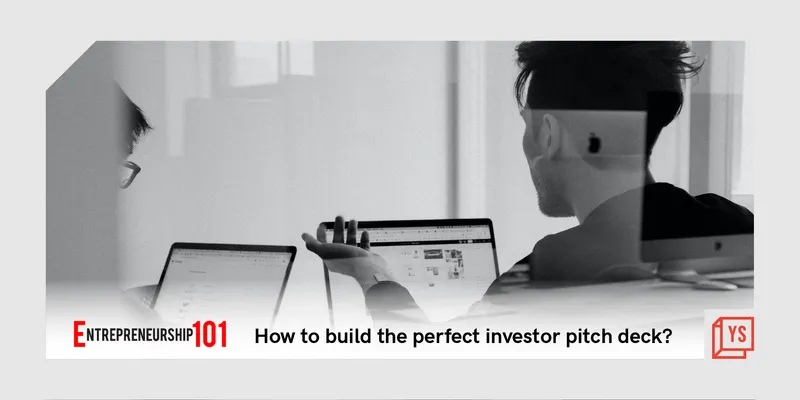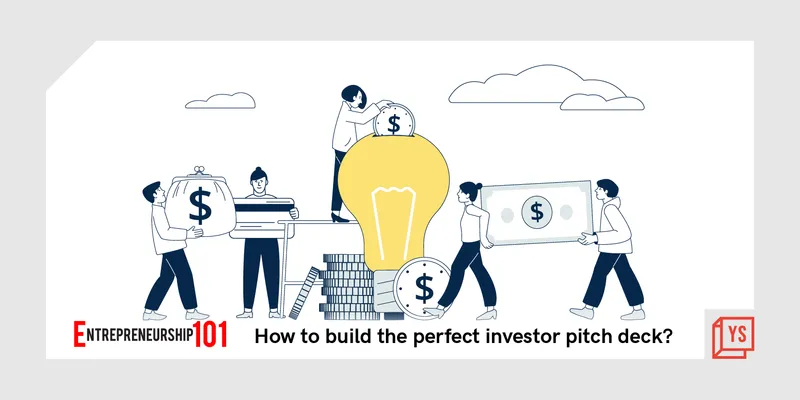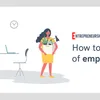Entrepreneurship 101: How to build the perfect investor pitch deck?
Entrepreneurship 101 aims to share ideas, references, and suggestions that can help startup founders tread the entrepreneurial path smoothly. This week, YourStory discusses how to build the perfect investor pitch deck.
Funding is an integral part of the startup ecosystem.
As of March 2022, India houses more than 65,861 startups and about 660 active investors. But not all startups succeed in raising the desired funds from their preferred investors.
This doesn’t always have to do with the product or the company. Oftentimes, entrepreneurs get stuck at the presentation level. How long or short it should be, what to include and what to avoid, and the list goes on.
Abhilash Sethi, Principal at agritech-focussed VC firm Omnivore, says, “A good pitch is a combination of brevity and clarity.”
Failing to bring out their strengths and convince investors has been a concern for every founder who has ever raised or plans to raise capital.
For this week’s article on Entrepreneurship 101, YourStory reached out to investors and entrepreneurs to understand what goes in a perfect pitch deck and what it takes to onboard an investor.

Presenting a vision
“The perfect pitch deck provides a significant vision of the company, validates it with data, and is clear in its ask,” Sailesh Ramakrishnan, Partner at Silicon Valley-based early-stage VC firm Rocketship.vc, tells YourStory.
He adds that the clarity of the vision and traction can make or break an investor pitch deck.
Omnivore primarily assesses startups based on the four Ts—team, technology, total addressable market (TAM), and traction. A startup must have founders with strong work experience (ideally in the startup ecosystem), build a solid tech infrastructure that is hard to replicate, strong early traction, a product-market fit, and a robust go-to-market strategy.
Also, if an entrepreneur wants Omnivore on its cap table, they must aim for simplicity—using legible fonts and not more than two colours.
Abhilash says, “Create the deck in a way that it tells a story of how the founders have developed the product, and avoid creating crowded slides.”
One of its portfolio startups, Stellapps, did just that. Co-founder and CEO Ranjith Mukundan tells YourStory, “Articulate the business concept and value proposition well, give a good glimpse of the rapid scale possibility, the execution team strength, and unit economics...not more than 10 slides.”
Omnivore’s Abhilash agrees that founders should create a short and clean presentation of not more than 10-15 pages, conveying a “Deep understanding of the problem statement and clearly explain the proposed solution.”
Anup Jain, Managing Partner at Orios Venture Partners, explains, “The longer it is, the harder it is to make an immediate decision.”
In fact, B2B-focussed micro VC firm Arali Ventures’s Founding Partner Arun Raghavan suggests that a ‘teaser pitch’ should not include more than eight slides.
Pitching as a category creator
For startups operating in a competitive market, it all comes down to who has the better pitch. Factors like team quality, tech structure, and business model eventually lead to the making or breaking of a deal.
Additionally, factors like the strength and market share of competing startups and the overall market saturation also affect an investor’s interest.
However, category creators—startups that carve a new market altogether—have to first prove that a potential market exists for their solutions.
“Investors wish to understand if there is a need for the solution and how it can potentially change user behaviour,” agrees Omnivore’s Abhilash.

He cites the example of portfolio company Fasal, a startup that uses artificial intelligence (AI) and Internet of Things (IoT) for farmers cultivating horticulture crops. Being one of the first movers in the smart-farming industry, Omnivore looked closely at the user feedback the startup was receiving and the robustness of its technology to eventually invest.
Similarly, Stellapps was founded in 2011, when the concept of farm-to-dairy digitisation was relatively new. Despite being a category creator, it went on to raise eight rounds of funding (a total of $40 million) from the likes of Blume Ventures, Bill & Melinda Gates Foundation, IndusAge Partners, Qualcomm Ventures, Omnivore, and Stride Ventures.
However, Stellapps did not get it right the first time, getting rejected at least the first dozen times. Ranjith says, “Our pitch evolved significantly over time, based on feedback from each pitch…with time and better commercial orientation, the message got simpler and articulate.”
Anup of Orios adds that category creators should be able to validate why the market for the said problem is large enough for a new solution to be tried and adopted. For a startup operating in a competitive market, only the latter is important. While a category creator’s pitch should focus more on describing the problem, a competitive startup should focus more on the solution, the differentiator and the leadership.
According to Aakash N S, Co-founder and CEO of Y Combinator-backed Jovian, the most important point in a pitch for a startup operating in a competitive market is “Why now?”
An entrepreneur has to justify why their solution is better than the existing options. This, however, should not be confused with dismissing the competitors. “Do not disparage the competition or talk disparagingly about any of your competitors,” advises Akshay Hedge, Co-founder and MD at ShakeDeal.
The checklist
Anup defines the perfect pitch as:
“A tight storyline consisting of the founders and their backgrounds including the passion and commitment to be in the space, the market sizing, the problem they are solving, the key stakeholders, their model and right to win including learnings from mistakes, and, their future projections matched with the usage of funds.”
However, in an attempt to list down all the important points, startup founders may often find themselves ending up with a deck that’s too long. After speaking with multiple investors, it is safe to say that an ideal pitch deck should not consist of more than 10 to 15 pages or slides.
Arali’s Arun believes that a pitch that focusses more on the solution without describing the problem can be a deal-breaker. He adds that to get an investor to fund a startup in its prototype stage, founders must dive deep to focus on the problem statement, include a hypothesis on how the problem can be solved and the revenue model, and share details about the go-to-market and scalability of the solution.

For entrepreneur Hardik Bhatia, focussing on the market size, USP, strength of the team, and plans for the funding helped him.
Earlier this month, his sustainable investment platform Sustvest raised its first round ($1,60,000) from a couple of angel investors and PIEDS Society. Hardik revealed that his pitch was not more than 10-minutes.
When asked what does it take to raise funds from Arali Ventures, Arun reveals that the startup should solve a specific problem for a business (irrespective of its size), provide visibility that the problem exists at scale and the solution can be scaled to multiple customers, and startup founders should be able to build conviction that the team has the right desire and tenacity to build the business.
When pitching to Rocketship.vc, startup founders should include details about the team, vision, traction, fundraising ask, and the use of the proceeds. “Entrepreneurs should be able to clearly define the vision of the company and back that up with relevant metrics and data,” says Sailesh.
While these are the essentials of any investor pitch deck, Akshay Chaturvedi, Founder and CEO of Leverage Edu believes that there is no ideal investor deck. “I am a fan of contextualising investor material based on some research,” he says.
Leverage Edu has raised $33 million over the last four years from the likes of Trifecta Capital, 9Unicorns, Blume Ventures, DSP Mutual Fund, and DSG Consumer Partners, among others.
“Your team, what they do, and how you are a world-beating combination together, along with your product roadmap is what makes a good pitch,” adds Akshay.
YourStory asked investors to list down points that should never make it to the pitch deck. Here’s a cumulative list:
- Detailed financial projections
- Motivational quotes and messages
- Influential people who do not directly work with the startup
- Long list of advisors and angels who are not particularly devoting any special time to ensuring the startup’s success
- Founders’ prior achievements
- Detailed discussion on the tech stack
- Generic market intelligence
- Complicated numerical analyses
- Product demos, unless they are going to blow the investors away or detailed product walkthrough videos
- Direct praise of the investor attending the pitch
- Valuation
- Exit strategy
- Merger and acquisition plan
“Your pitch is your first chance to make an impression…it should deliver your authentic story,” Sonam Srivastava, Founder at AI-powered seed-funded wealth management startup Wright Research, concludes.
To read more articles on Entrepreneurship 101, click here.
Edited by Saheli Sen Gupta









